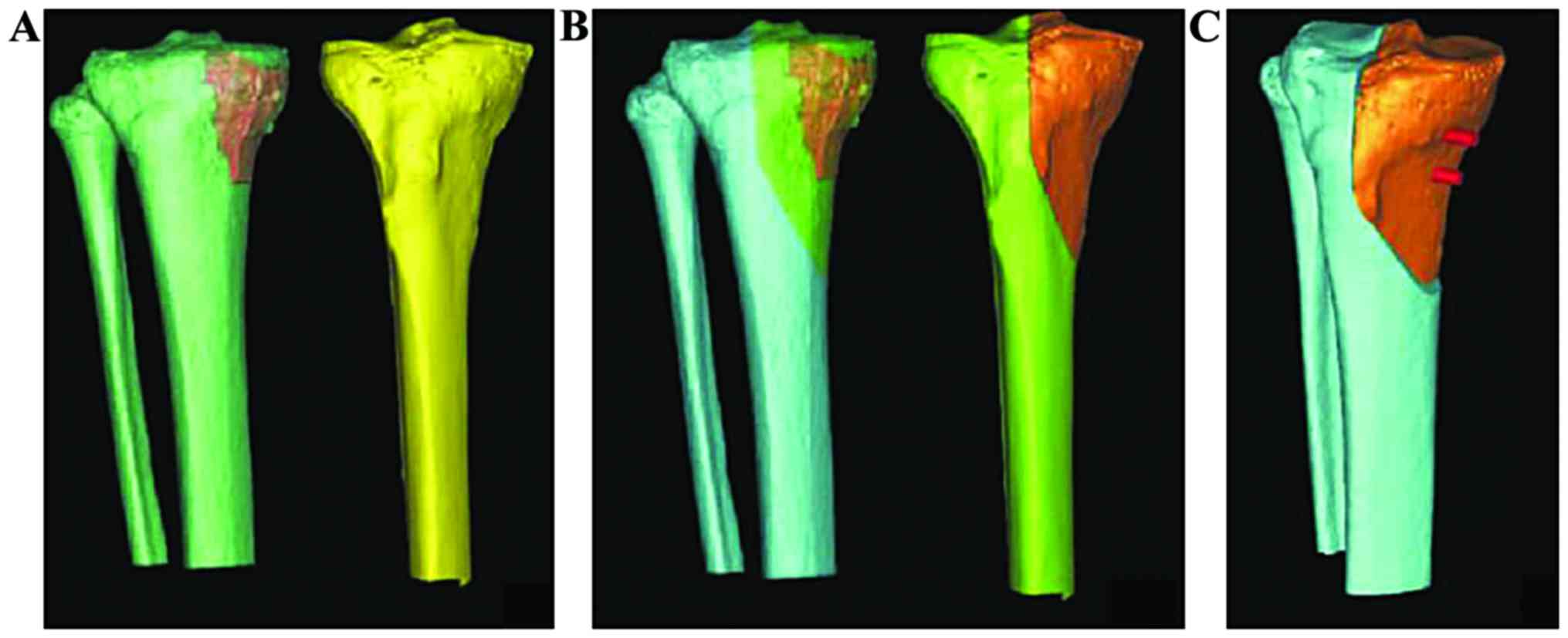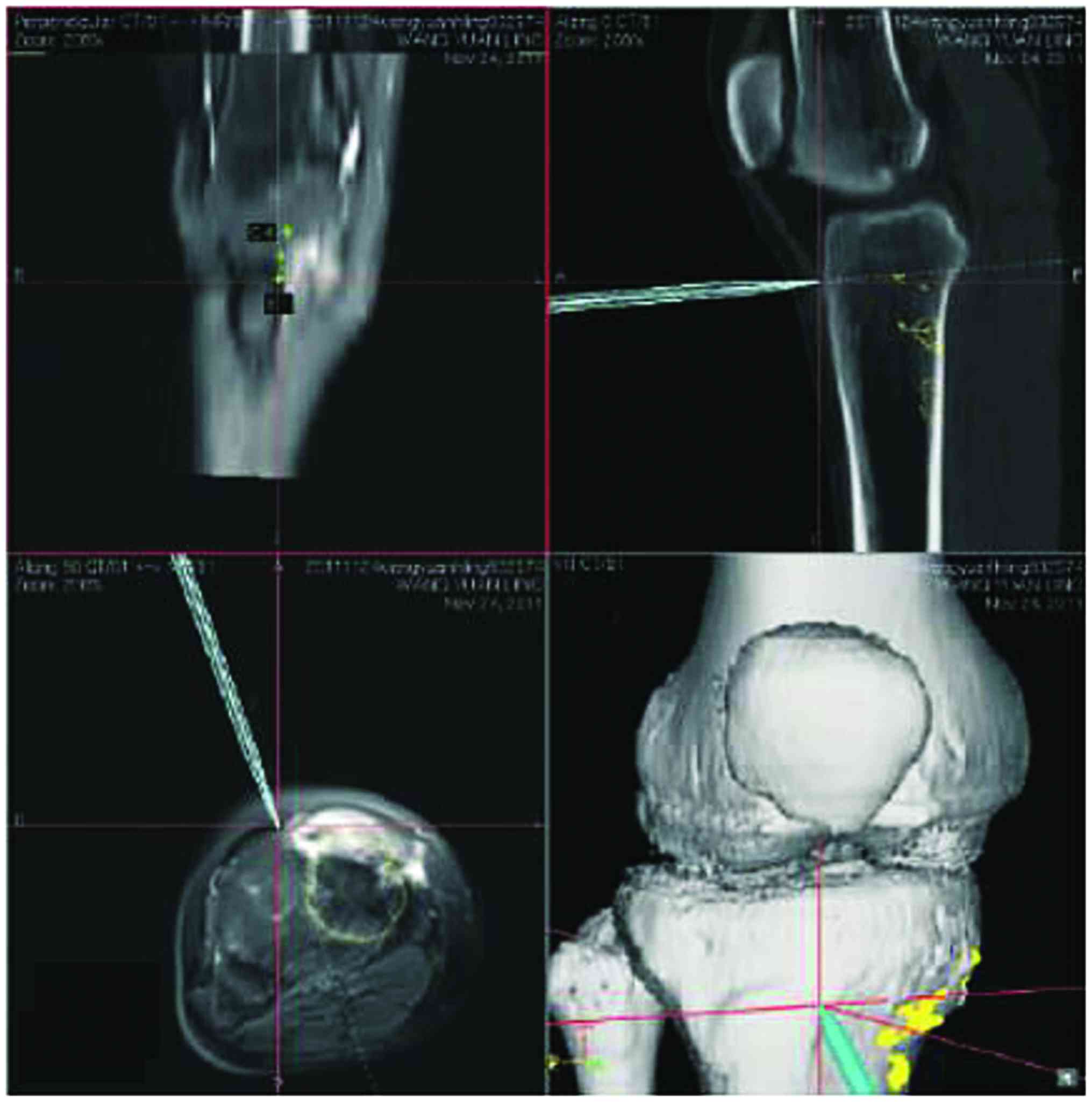|
1
|
Zhang P, Feng F, Cai Q, Yao W, Gao S, Wang
J and Wang X: Effects of metaphyseal bone tumor removal with
preservation of the epiphysis and knee arthroplasty. Exp Ther Med.
8:567–572. 2014.PubMed/NCBI
|
|
2
|
Wong KC and Kumta SM: Joint-preserving
tumor resection and reconstruction using image-guided computer
navigation. Clin Orthop Relat Res. 471:762–773. 2013. View Article : Google Scholar : PubMed/NCBI
|
|
3
|
Rabitsch K, Maurer-Ertl W, Pirker-Frühauf
U, Lovse T, Windhager R and Leithner A: Reconstruction of the
distal radius following tumour resection using an osteoarticular
allograft. Sarcoma. 2013:3187672013. View Article : Google Scholar : PubMed/NCBI
|
|
4
|
Wong KC and Kumta SM: Use of computer
navigation in orthopedic oncology. Curr Surg Rep. 2:472014.
View Article : Google Scholar : PubMed/NCBI
|
|
5
|
Aponte-Tinao L, Ritacco LE, Ayerza MA,
Muscolo DL, Albergo JI and Farfalli GL: Does intraoperative
navigation assistance improve bone tumor resection and allograft
reconstruction results? Clin Orthop Relat Res. 473:796–804. 2015.
View Article : Google Scholar : PubMed/NCBI
|
|
6
|
Nakamura T, Matsumine A, Uchida A, Kawai
A, Nishida Y, Kunisada T, Araki N, Sugiura H, Tomita M, Yokouchi M,
et al: Clinical outcomes of kyocera modular limb salvage system
after resection of bone sarcoma of the distal part of the femur:
The Japanese Musculoskeletal Oncology Group Study. Int Orthop.
38:825–830. 2014. View Article : Google Scholar : PubMed/NCBI
|
|
7
|
Ogilvie CM, Crawford EA, Hosalkar HS, King
JJ and Lackman RD: Long-term results for limb salvage with
osteoarticular allograft reconstruction. Clin Orthop Relat Res.
467:2685–2690. 2009. View Article : Google Scholar : PubMed/NCBI
|
|
8
|
Fan H, Guo Z, Wang Z, Li J and Li X:
Surgical technique: Unicondylar osteoallograft prosthesis composite
in tumor limb salvage surgery. Clin Orthop Relat Res.
470:3577–3586. 2012. View Article : Google Scholar : PubMed/NCBI
|
|
9
|
Gharedaghi M, Peivandi MT, Mazloomi M,
Shoorin HR, Hasani M, Seyf P and Khazaee F: Evaluation of clinical
results and complications of structural allograft reconstruction
after bone tumor surgery. Arch Bone Jt Surg. 4:236–242.
2016.PubMed/NCBI
|
|
10
|
Aponte-Tinao LA, Ayerza MA, Muscolo DL and
Farfalli GL: Allograft reconstruction for the treatment of
musculoskeletal tumors of the upper extremity. Sarcoma.
2013:9254132013. View Article : Google Scholar : PubMed/NCBI
|
|
11
|
Teunis T, Nota SP, Hornicek FJ, Schwab JH
and Lozano-Calderón SA: Outcome after reconstruction of the
proximal humerus for tumor resection: A systematic review. Clin
Orthop Relat Res. 472:2245–2253. 2014. View Article : Google Scholar : PubMed/NCBI
|
|
12
|
Wong KC and Kumta SM: Computer-assisted
tumor surgery in malignant bone tumors. Clin Orthop Relat Res.
471:750–761. 2013. View Article : Google Scholar : PubMed/NCBI
|
|
13
|
Meijer MF, Stevens M, Boerboom AL, Bulstra
SK and Reininga IH: The influence of computer-assisted surgery on
rotational, coronal and sagittal alignment in revision total knee
arthroplasty. BMC Musculoskelet Disord. 15:942014. View Article : Google Scholar : PubMed/NCBI
|
|
14
|
Ding HW, Yu GW, Tu Q, Liu B, Shen JJ, Wang
H and Wang YJ: Computer-aided resection and endoprosthesis design
for the management of malignant bone tumors around the knee:
Outcomes of 12 cases. BMC Musculoskelet Disord. 14:332013.
View Article : Google Scholar : PubMed/NCBI
|
|
15
|
Wang W, Bi WZ, Yang J, Han G and Jia JP:
Pelvic reconstruction with allogeneic bone graft after tumor
resection. Acta Ortop Bras. 21:150–154. 2013. View Article : Google Scholar : PubMed/NCBI
|
|
16
|
Cheng B, Lu SL and Fu XB: Regenerative
medicine in China: Main progress in different fields. Mil Med Res.
3:242016. View Article : Google Scholar : PubMed/NCBI
|
|
17
|
Ort R, Metzler P, Kruse AL, Matthews F,
Zemann W, Grätz KW and Luebbers HT: The reliability of a
three-dimensional photo system (3dMDface) based evaluation of the
face in cleft lip infants. Plast Surg Int.
2012:1380902012.PubMed/NCBI
|
|
18
|
Al Eissa S, Al-Habib AF and Jahangiri FR:
Computer-assisted navigation during an anterior-posterior en bloc
resection of a sacral tumor. Cureus. 7:e3732015.PubMed/NCBI
|
















